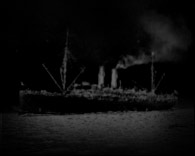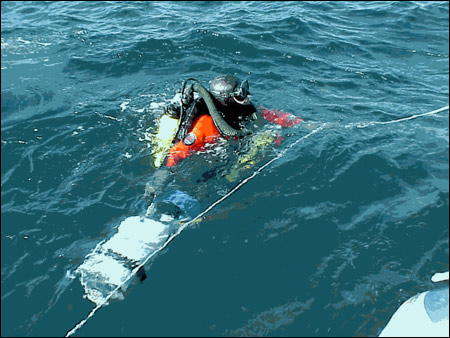 |

The S.S. Governor | Historical archives | Underwater images/video | Exploration updates
August 2, 2006 (read previous report)
Richard Brown and I (Peo Orvendal) met the first team (Walter Jaccard, Joe Radosevic and Mark Tourtellot) in Port Townsend, helped them unload their gear, and load ours. We then drooled over the blueprints of the Governor while waiting for the time to leave the dock.
We couldn't have been met by better conditions. Only small wind waves, the sun was shining and a mellow tidal exchange. The buoy was still in place, and after Mike had cleared us with the vessel traffic control, Richard and I geared up, jumped in the water with our doubles, a 70' bottle, an O2 bottle and a scooter each. We held on to the current line hanging off the buoy while doing some quick bubble checks.
I didn't quite know what to expect on the way down. I felt humbled by the sheer size of this wreck, by the complexity of the layout that I learned from the blueprints, and its reputation as the "Mount Everest" as Mark and others more experienced than me like to put it. I know of some divers that have had to do MANY attempts at getting down on the wreck without succeeding, and I know some of them consider this to be a more complex and difficult dive than the Andrea Doria. I have no idea on whether that is true or not, but if nothing else, it added an extra level of anticipation and perhaps a bit of nervousness as well as I hit the trigger and we left the surface behind us. We had a smooth descent that brought us down to the anchor which was jammed inside one of the caved in stern cabins. The descent took us two minutes and thirty seconds, and we had more current on the way down than what I would have been comfortable swimming against.
While Richard unhooked the downline so it could be retrieved, I stayed put (which did require some scootering due to the current) and looked around. We were at about 220' below the surface, and the wreck was far beyond any expectation I had had. It was the coolest thing I've ever seen under water. I could make out the green tint of the ambient light coming down all the way from the surface. Visibility was only limited by the power of my Halcyon 18W HID.
When Richard was done, we peeked around together, and started looking for one of the corridors than ran (and still runs) inside the wreck. The topmost floors are caved in, but underneath that, there are still intact cabins and corridors. We found a promising opening in the wreck. I took out the reel and tied off, and then we scootered in.
There were HUGE barnacles on the floor, and while relatively wide, it wasn't that high and I had no interest in punching a hole on my drysuit on one of those barnacles, so I ran the scooter out on my right side rather than the normal position underneath and out in the front. About 100' in, the ceiling had collapsed partially down. We could still probably push ourselves through swimming, but I had no interest doing that on my first dive on the wreck. The opening looked promising though, and may be worth exploring if I can find it again on my next dive on the wreck.
The corridor we were in was just beautiful. You could pick out various ship details such as a toilet and some plates, and it was all covered in sponges, anemones and the huge barnacles. It was as decorated as any cave I've been in. :-) And for once, the sea life wasn't disturbing or distracting. I normally find that it is just "in the way" when I want to look at the wreck, but here it complemented it in such a beautiful way. I turned the penetration, and Richard and I swam the same way back out again.
We then scootered up across the superstructure and over the the bow of the ship, some 350 feet further away. In one place, probably above the engine room where the smoke stacks had once been, it had caved in more than elsewhere. Just as we were coming out of from the 'ledge' so we could see into the hole, a HUGE, and I mean HUGE, red snapper was sitting out in the open. It looked like 6' long, so it was probably about 5'. :-) I screamed 'holy f#ck' through my regulator, and I heard Richard shouting something very similar as well. The current was beginning to really pick up, so we dropped down on the side of the ship to get some lee since we otherwise had to swim our scooters to make progress towards the bow. I recall thinking that I would definitely NOT like to do this dive without a scooter and a very dependable buddy. Doing this without a scooter would mean seeing just a tiny portion of the wreck, and continuously focusing on finding the next lee spot that you can jump to, rather than enjoying the scenery. That said, even with scooters we had to be really careful. There are so many ribs and pieces of extremely sharp metal sticking up out of the wreck that if you don't pay careful attention to where you are, you will rapidly drift into something as soon as you let go of the trigger, or, even worse, drift into one of the cavernous openings.
Richard and I crossed over to the other side of the ship again as we approached the bow, and spotted an ENORMOUS cleat and three beautiful port holes that were probably 15 inches in diameter, with the glass and brass still intact (actually one of them had a crack in the glass). There was even more sea life growing on the inside of the glass that on the outside, which looked very strange.
We again scootered up on top of the wreck, and drifted over the beautiful wreck back to the stern section. The stern is the really smashed up part of the over 400' long wreck. When she sank, she sank stern first, and it shows.
The stern is still pretty interesting to look at, despite it being so mangled. There are toilets, tiled floors, chamber pots and dinner plats spread all over it (and many other parts of the wrecks too).
We drifted off the stern, looked at each other, and thumbed the dive at 24 minutes of runtime. From 180' and up I had enough ambient light to see my gauges without my light (though we of course used them since they help communications and team positioning). Our first deep stop was at 160', and I shot a surface marker from 120' so the boat could follow us. Walter greeted us at 90', and managed communication with the surface and taking our 70' bottles and scooters off of us when we got up to 30'.
We only spotted one dogfish during deco.
After about 85 minutes, we broke the surface. The small waves we had had when we jumped in had settled down and the Inlet was almost as flat as a mirror.
Can you ask for a better dive?
- posted by Peo Orvendal
The first team in the water, Andrew Georgitsis and Brock Wheaton, used Halcyon rebreathers and Gavin scooters to produce the footage from the stern to the bow. They were able to do some penetration work and dropped into the heart of the ship. An extremely successful dive and they were able to produce some excellent footage for further review from both Mester and the TV Crew. The second team, Walter Jaccard and Pat Paustain, used Hogarthian systems, and focused their efforts on the stern of the vessel looking for the safe. Their 25 min bottom time produced some footage as well as some artifacts which were given to the Washington State Historical Society and entered into the historical database.

Picture of Brock Wheaton ready to go.

Picture of a bowl & insignia recovered from the SS Governor by diver Pat Paustain.

The team photo.
